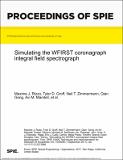Simulating the WFIRST coronagraph integral field spectrograph
Author(s)
Cady, Eric; Mejia Prada, Camilo; Rizzo, Maxime J.; Gong, Qian; Groff, Tyler D.; Krist, John E.; Mandell, Avi M.; McElwain, Michael W.; Riggs, A. J. Eldorado; Saxena, Prabal; Zimmermann, Neil T.; Brandt, Timothy; Roberge, Aki; Douglas, Ewan S.; Cahoy, Kerri; ... Show more Show less
Download104000B.pdf (2.708Mb)
PUBLISHER_POLICY
Publisher Policy
Article is made available in accordance with the publisher's policy and may be subject to US copyright law. Please refer to the publisher's site for terms of use.
Terms of use
Metadata
Show full item recordAbstract
A primary goal of direct imaging techniques is to spectrally characterize the atmospheres of planets around other stars at extremely high contrast levels. To achieve this goal, coronagraphic instruments have favored integral field spectrographs (IFS) as the science cameras to disperse the entire search area at once and obtain spectra at each location, since the planet position is not known a priori. These spectrographs are useful against confusion from speckles and background objects, and can also help in the speckle subtraction and wavefront control stages of the coronagraphic observation. We present a software package, the Coronagraph and Rapid Imaging Spectrograph in Python (crispy) to simulate the IFS of the WFIRST Coronagraph Instrument (CGI). The software propagates input science cubes using spatially and spectrally resolved coronagraphic focal plane cubes, transforms them into IFS detector maps and ultimately reconstructs the spatio-spectral input scene as a 3D datacube. Simulated IFS cubes can be used to test data extraction techniques, refine sensitivity analyses and carry out design trade studies of the flight CGI-IFS instrument. crispy is a publicly available Python package and can be adapted to other IFS designs.
Date issued
2017-09Department
Massachusetts Institute of Technology. Department of Aeronautics and Astronautics; Massachusetts Institute of Technology. Department of Earth, Atmospheric, and Planetary Sciences; Massachusetts Institute of Technology. Department of PhysicsJournal
Techniques and Instrumentation for Detection of Exoplanets VIII
Publisher
SPIE-Intl Soc Optical Eng
Citation
Roberge, Aki, Eric Cady, Camilo Mejia Prada, Maxime J. Rizzo, Ewan S. Douglas, Kerri L. Cahoy, Qian Gong, et al. “Simulating the WFIRST Coronagraph Integral Field Spectrograph.” Edited by Stuart Shaklan. Techniques and Instrumentation for Detection of Exoplanets VIII (September 1, 2017).
Version: Final published version
ISBN
9781510612570
9781510612587